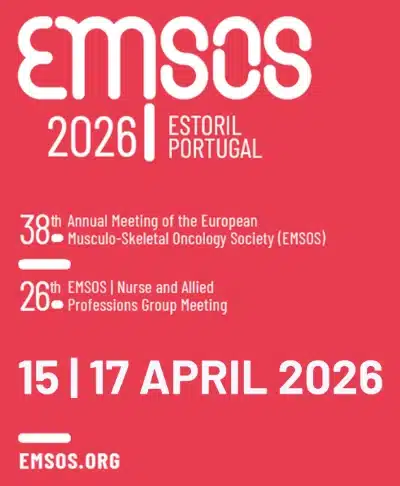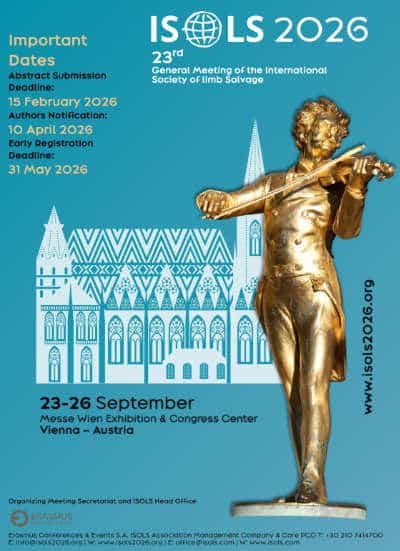Minimal Dataset and Data Dictionary for global sarcoma registries
We are happy to present the attached minimal dataset and data dictionary, containing explanations of all data elements. Please incorporate these into your practice and begin collecting data on your patients.
If you would like to receive an example REDCap collection instrument and/or Excel version of the dataset, please contact our research coordinator Abby Grothe (abigail-grothe@uiowa.edu), who will gladly provide these and serve as contact for all questions related to this effort.
Corresponding address
The International Registry Work Group
Ben Miller, Adam Levin, Andreas Leithner, Joanna Szkandera, Marcos Galli, Ricardo Becker, Luke Johnson, Ashish Gulia, Eric Staals, Masood Umer, and Abby Grothe
Contact
Abby Grothe
abigail.grothe@uiowa.edu
EMSOS studies planned/ ongoing
Use of 3D printed PSI +/- CAS for bone tumor resection AND for allograft shaping in children and adults – an EMSOS study
We are pleased to invite you to participate in the multicenter study evaluating the use of 3D printed patient specific instruments (PSI) and/or computer assisted surgery (CAS) for both bone tumor resection AND for allograft shaping, in children and adults.
First, planning strategies are evaluated for intercalary and hemicortical resections, including choices on form, shape and size of the osteotomies, pearls and pitfalls of saw guide design, dealing with soft tissues, use of FVFG and type of fixation.
Second, procedural outcome measurements are made and compared on preoperative and postoperative imaging. Gap sizes and procedural accuracy for both host bone and allograft are measured and time to union calculated.
Third, clinical outcomes will be evaluated including time to union, time to full weight bearing and complications related to the techniques used.
Corresponding address
Jasper Gerbers / Michiel van de Sande
Leiden University Medical Center, Leiden, the Netherlands
j.g.gerbers@lumc.nl / majvandesande@lumc.nl
Lizz van der Heijden / Michiel van de Sande
Princess Máxima Center for Pediatric Oncology, Utrecht, the Netherlands
l.vanderheijden-9@prinsesmaximacentrum.nl / m.a.j.vandesande-2@prinsesmaximacentrum.nl
Reconstructive options after bone sarcoma resection in children younger than 10 years old – an EMSOS study
We all face dilemmas concerning bone tumor resection and subsequent reconstructive options especially in the smallest children. Therefore, we feel that there is room for an EMSOS study platform on small children and we are pleased to invite you to participate in this multicenter study.
First, different reconstructive options will be evaluated for different localizations and different age ranges, including their oncological and functional outcomes. In addition, limb length discrepancies and growth disorders during further length growth and scheduled secondary surgeries to solve this are also evaluated.
Second, we will send out a survey among orthopedic oncologist including various pediatric cases to see what choices are made, in which patients, whether shared decision making is used, what techniques are preferred (biological, prosthetics, temporary spacer, rotationplasty or amputation etc), when radiotherapy is considered (or not), and how life plans considering length growth and corrections until skeletal maturity are made.
Corresponding address
Lizz van der Heijden / Michiel van de Sande
Princess Máxima Center for Pediatric Oncology, Utrecht, the Netherlands
l.vanderheijden-9@prinsesmaximacentrum.nl / m.a.j.vandesande-2@prinsesmaximacentrum.nl
Association between IDH1 R132 Mutations and Prognosis in Chondrosarcoma
We are pleased to invite you to participate in the multicentric retrospective study “Association between IDH1 R132 Mutations and Prognosis in Chondrosarcoma”.
Corresponding address
Giulia Trovarelli
Department of Orthopaedics and Orthopaedic Oncology
Padova, Italy
E-Mail: Giulia.trovarelli@aopd.veneto.it
Study Protocol Proximal Tibia Reconstruction
We herein invite You to participate in the following retrospective multicentre study. Given the fact that the proximal tibia is one of the most frequently affected locations for primary bone tumours, sufficient reconstruction of the adjacent knee joint is of importance. The aim of this multicentre study is to analyse clinical outcomes of patients treated for soft tissue and bone neoplasms (benign, locally aggressive; malignant) of the proximal tibia. As the current literature provides few information on reconstruction-technique-dependent outcomes following surgery for bone and soft tissue neoplasms involving the proximal tibia, the current multicentre retrospective study may allow to draw further conclusions on how to best approach tumours at this specific anatomical location.
Corresponding address
Santiago A. Lozano-Calderon
Paul Jutte
Oncology, Infection, Reconstruction, University Medical Center Groningen
Hanzeplein 1, 9700 RB Groningen, The Netherlands
p.c.jutte@umcg.nl
Ewing-like sarcomas of bone and soft tissues: entities, strategies and outcomes.
Dear Colleagues,
hereby we invite you to participate in the multicentric retrospective study “Ewing-like sarcomas of bone and soft tissues: entities, strategies and outcomes”. The primary aim is to assess mid- to long-term survival of Ewing-like sarcoma patients (both soft tissues and bones). Further endpoints include outcome stratification according to parameters as tumour site and tumour stage at diagnosis, as well as the identification of risk factors independently associated with worse survival.
Corresponding address
Michele Fiore
Department of Orthopedics and Traumatology
IRCCS Azienda Ospedaliero-Universitaria di Bologna, Italy
michelefiore.md@gmail.com
Chondrosarcoma G2
Chondrosarcoma is one of the most frequent primary bone sarcoma. The most affected subjects are adults around the fifth-sixth decades of life. Central chondrosarcoma (CS) is graded on a scale of 1 to 3 according to histological criteria. These tumors can be divided into low-grade (Grade 1) and high-grade (Grade 2, Grade 3, and dedifferentiated) chondrosarcomas. However, the histological grade should be correlated with imaging and the clinical presentation for an optimal diagnosis. En-bloc resection has been the most widely used treatment for grade 2-3 CS, whereas for patients with low-grade CS, curettage is safe and effective. This approach requires an accurate preoperative estimation of grade to avoid under- or overtreatment, but prior reports have indicated that both imaging and biopsy do not always give an accurate prediction of grade. It is still debated on what to do in case of a high-grade CS that have been undertreated because of wrong preoperative estimation of grade.
Corresponding adress
Andrea Sambri, MD PhD
Orthopaedic Oncology and Trauma Surgeon
IRCCS University Hospital Sant’Orsola
Via Massarenti 9 Bologna, Italy
+39 3332683222
+39 051 214 2680
andrea_sambri@libero.it
andrea.sambri@aosp.bo.it
andrea.sambri2@unibo.it
Member of the European Muscoloskeletal Oncology Society – EMSOS
Italy Country Delegate of the European Bone and Joint Infection Society – EBJIS
Total Femur Replacement: Functional Outcome, Clinical Results and Gait Analysis.
Dear colleagues, hereby we invite you to participate in the multicentric retrospective study “Total Femur Replacement: Functional Outcome, Clinical Results and Gait Analysis”.
Total femur replacements (TFR) are very rare and associated with high complication and failure rates. To our knowledge, there is no literature regarding further specific functional analysis including gait analysis for patients who underwent a total femur replacement. Due to patients’ higher demand for a good functional outcome, and a better oncological outcome, we believe there is a need for further investigation and for larger data in order to draw conclusions. Outcomes of total femur replacements for oncological or non-oncological indications will be analyzed. A competing risk and event analysis of the protheses survival will be performed. Additionally, gait analysis will provide further insight about functional performance.
Corresponding adress
Dr. Marisa Valentini
Medical University of Graz
Austria
marisa.valentini@medunigraz.at
Primary leiomyosarcoma of bone (LMSoB)
Primary leiomyosarcoma of bone (LMSoB) is a rare subtype of bone sarcomas, accounting for less than 0.7% of all malignant bone tumours. The aim of this study is to extend existing data on patients with LMSoB with further cases one to increase the dataset to a sufficient number of patients, eventually allowing to draw conclusions on behavior and treatment response of this extremely rare tumor entity.
Corresponding adress
Dr. Maya Niethard
Clinic for Tumor Orthopedics, Helios Clinic Berlin-Buch
Schwanebecker Chaussee 50
13125 Berlin
Germany
maya.niethard@helios-gesundheit.de
+49 (0)30-9401-55800
Periprosthetic Joint Infection in Megaprostheses following Bone Sarcomas
Infection rate in end-prosthetic reconstruction ranges from 3 to 30%, with even 60% for revision arthroplasty. Due do use of neoadjuvant chemotherapy, bone sarcoma patients are at particularly high risk to develop periprosthetic joint infections (PJI). This EMSOS study aims at systematically collecting data from patients treated for PJI of megaprostheses following reconstruction for bone sarcoma surgery.
Contact
Dr. Andrea Sambri
Email: andra.sambri@aosp.bo.it
A retrospective study of local relapse after high grade osteosarcoma
Aim of this study is to analyse the modalities of diagnosis of LR in high-grade osteosarcoma, pattern of recurrence, treatment of LR and factors influencing post-LR survival (PLRS) focusing on the role of second line chemotherapy, margins and type of surgery
Contact
Emanuela Palmerini, Bologna
Email: emanuela.palmerini@ior.it
PROJECT: Tumors at the elbow – clinical and oncological results after resection and endoprosthesis replacement
Invitation to participate the study
Dear colleagues, hereby we invite you to participate in a multicentric retrospective study “Tumors at the elbow – clinical and oncological results after resection and endoprosthesis replacement”.
Bone and soft tissue tumors involving the elbow are very rare. There is a limited knowledge about clinical and oncological results of distal humerus and/or proximal ulna resection and endoprosthetic elbow reconstruction: in the last two decades only a few publications analyzed this problem, including per study at average about 20 patients. These studies include numerous various parameters (different implants, various diagnosis…), making the task of summarizing the results not easy.
Contact
Dr. Marko Bergovec
marko.bergovec@medunigraz.at
EMSOS study “Sarcoma during Pregnancy”
Malignancy during pregnancy is a very rare entity with an estimated incidence of 1/1000 pregnancies. Individual therapeutic customization is the only choice of treatment with respect to the health of the mother, and her child.
The occurrence of sarcoma during pregnancy is even more exceptional, with about 140 reported cases in the accessible literature. 60% is reported as primary soft tissue sarcomas, 40% as primary bone sarcomas. No true systematic study has been undertaken to investigate the whole diagnostic, therapeutic and prognostic concept of these sarcomas during pregnancy as an ‘entity’.
Contact
University Department of Experimental Pathology, Vrije Universiteit Brussel, Belgium.
Prof. dr. Ramses Forsyth, director (ramses.forsyth@vub.be).
Mazabraud syndrome
Mazabraud Syndrome is a very rare combination of fibrous dysplasia (FD) and intramusculary myxomas. Both entities are caused by activating GNAS-mutations and while FD is often diagnosed at a younger age, myxomas tend to arise later, often in the fourth or fifth decade of life, and are localized adjacent to FD lesions in the majority of the patients. The myxomas can lead to mechanical problems and symptoms of pain. Excision of the myxomas has been proposed, although outcome of surgical interventions and whether there are predictive factors for recurrence of the myxomas remains eluded.
If you need any assistance please contact Bas Majoor, b.c.j.majoor@lumc.nl
EMSOS Study "Angiosarcoma"
Angiosarcoma is the malignant end of the spectrum of vascular tumors, spanning diagnosis including hemangiomas, hemangioendothelioma, well-differentiated and poorly-differentiated angiosarcoma.
Angiosarcoma of bone is rare, accounting for <1% of all primary bone sarcomas and it is associated with a poor prognosis. Although any age can be affected, the incidence is highest between 50 and 70 years of age.
Angiosarcoma of bone may present as unifocal or multifocal disease. The most common locations of unifocal tumor are the long and short tubular bones, followed by the pelvis, and trunk.
Histologically, angiosarcomas of bone are composed of anastomosing vascular channels lined by atypical endothelial cells with enlarged nuclei, prominent nucleoli, and increased mitoses. Inflammatory cells, mostly eosinophils, may be present.
Given the rarity of angiosarcoma of bone, the literature is limited regarding treatment and outcome of patients with this tumor.
The role of chemotherapy and prognostic factors for these patients remain unclear.
Under the auspices of the EMSOS, a retrospective study has been launched with the aim of improving our knowledge on the natural history of the tumor and on prognostic and predictive factors of survival.
Contact
Stefano Ferrari MD
SSD Chemioterapia dei Tumori Muscoloscheletrici
Istituto Ortopedico Rizzoli – WWW.ior.it
Via Pupilli 1, 40136 Bologna. Italy
Stefano.ferrari@ior.it
DGOOC / EMSOS study "Clear cell sarcoma"
Osteosarcoma after retinoblastoma
Contact
Sebastian Asaftei, Torino / sebastiandorin.asaftei@unito.it
European Relapsed Osteosarcoma Registry "EURELOS"





